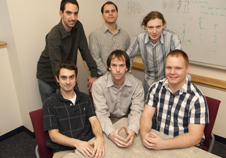A brainy innovation takes flight

A team of Northeastern University engineering students has developed a system that allows a pilot to fly a simulated airplane using nothing more than his or her brainwaves — a program that has piqued military and private-sector interest.
As part of their senior-year capstone project, students Nathaniel Kaye, Hamilton Kibbe, Boris Lippeveld, Kyle Mueller, Mike Nedoroscik and Rafael Perez developed an interface that lets a pilot control a simulated airplane by looking at specific points on an array of LEDs mounted on plexiglass in front of a television screen.
“Typically, a pilot has a joystick and a throttle and those allow him or her to do a myriad of things,” said Nedoroscik, the team leader. “We were able to identify the absolute essential controls and write them into the software. We’ve been able to achieve up to eight commands, which allowed us to fly the plane and do a couple of flight maneuvers.”
The group was supervised by Waleed Meleis, an associate professor of electrical and computer engineering, and worked closely with Assistant Professor Deniz Erdogmus, a brain-computer interface expert. During the two semesters they spent working on the project, Erdogmus gave the group access to his equipment, which allows a user to control computers or robots with signals from different parts of the body.
Engineering capstone projects provide students with a rich experiential-learning opportunity, enabling them to pursue their innovative ideas through use-inspired research at a level of complexity more typical of graduate studies.
“We really want it all to come together in one project,” Meleis said of the capstone process. “That’s more similar to what students will be doing when they leave Northeastern. They’ll be working on projects that don’t have answers already established and don’t limit themselves to one field or discipline.”
Using an open-source flight simulator called FlightGear, the group was able to design a computer system that could distinguish between eight commands at a rate of two seconds per command, achieving accurate results about 80 percent of the time.
The team presented their computer programs to program directors at the Defense Advanced Research Projects Agency, and inspired an internal grant at Honeywell Inc. to pursue similar research.
Members of the team said the skills they developed on the project would be relevant in their careers outside Northeastern.
“I think it was very applicable, having to work in a group on a project of this magnitude,” Nedoroscik said. “This is really the first time that we’ve tackled something of this magnitude as students working on our own, but we had to behave like professionals and report progress like professionals. This wasn’t a homework assignment — this was something we had to start from scratch and finish all the way to the end.”





